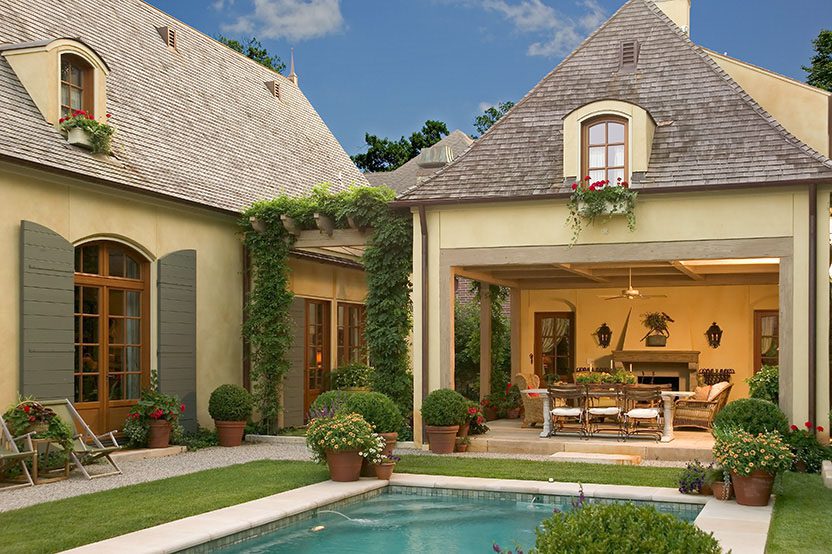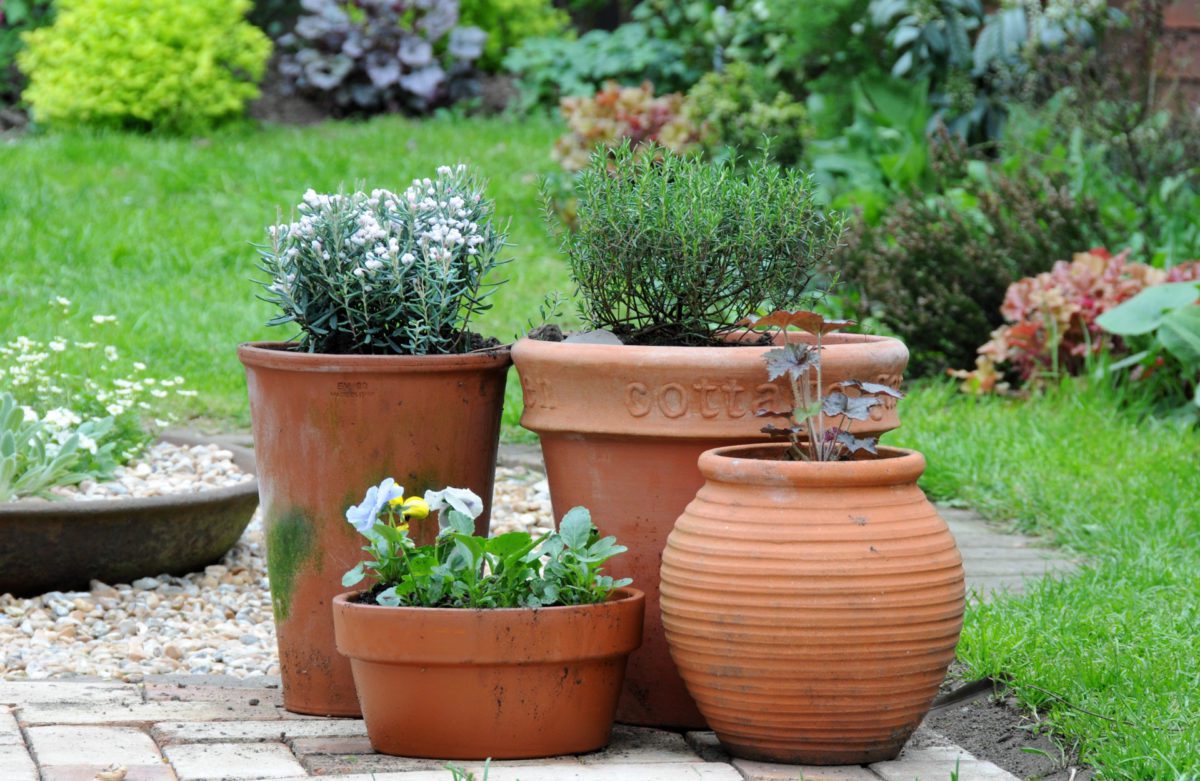Trends In-Home
Holistic design as homage to nature, along with eco-conscious use of materials, are leading the current home trends. Examples include open atriums – bringing the flora, fauna and actual trees indoors. Perhaps this is why the rich, natural hues of deep red, brown and green are trending.
“I do like rich colors, either for a library or living room – certainly not for bedrooms,” says James Steinmeyer, owner of Tulsa-based Easton-Steinmeyer & Associates. “At present, we are doing a deep chocolate brown in a shiny vinyl for a library, and in a living room with a wall of windows, a deep dark avocado color, in a shiny lacquer. I would generally not do such a saturated color in a living room, but with the light from the windows playing on the lacquer walls, it adds a great deal of interest.”
Right-sizing – older generations looking to move or remodel to suit their current lifestyle – continues to play a role in interior design choices.
“I would think that with changing lifestyles, it certainly will happen to all of us,” says Steinmeyer. “You must be brave and edit what you no longer need or what will not fit into a new space. There is no sense in trying to force what might have worked in another life into your new life. Change is good for all of us.”
Also trending in interior design is an emphasis on multi-functionality for rooms.
“I have lived in multipurpose rooms all my life, because of living in NYC for most of my adult life,” says Steinmeyer. “For me, it is easy to understand and hopefully convince clients that it is an easy way to live.”
While interior design trends like ‘cottage core’ and ‘grandma chic’ wax and wane in popularity, some never go out of style.
“Our office has mixed antiques with modern pieces, for what now seems like a long time,” he says. “It is what makes for an interesting room – and one which is not stuck in time.”
Trends Outside the Home
Pandemic-related challenges of recent years resulted in deeper and renewed interest in greenspaces, yards and plants. From using environmentally friendly wood-based compost alternatives to focusing on climate-resilient plants, many homeowners are discovering their green thumbs.
“People are rediscovering their backyards,” says Casey Hentges, host of OSU Extension’s Oklahoma Gardening Show. “When people couldn’t get out many places, they could still go to plant nurseries and parks. Then with grocery prices rising, people are interested in growing vegetables to at least supplement their grocery buying.”
This deeper appreciation means many things, including embracing nature’s less-loved species as part of the cycle of growth – such as slugs that help recycle decaying material and aphids that provide food for ladybirds, lacewing and hoverfly larvae.
“People are reevaluating having a green lawn space and are wanting plant materials that invite pollinators,” says Hentges. “These days, there seems to be more of a conscious thought of our ecosystem and not just of creating a pretty yard. People are more aware of the pollinators. Same with spraying anything on plants, people are more aware of how it impacts pollinators and the life in the soils, earthworms, slugs – all of it.”
Herb Gardens
Julia Laughlin, Oklahoma County OSU Extension horticulture educator, has seen a pronounced uptick in food and herb garden interest – especially among the easiest things to grow, like radishes, lettuce and certain herbs.
“There’s a resurgence in interest in culinary gardening and, since the pandemic, people are focused on fresh food,” says Laughlin. “We’re looking to our backyard to see what we can grow in even a little space, and so we’ve seen a huge influx of questions about backyard culinary gardens, canning and preserving, and in herb gardens – because they’re realizing it’s pretty easy to grow tomatoes, peppers and herbs.”
Laughlin lists basil among the top sought herbs with its ease of growth and variety of flavors like lemon, Thai and cinnamon. Another favorite is rosemary which, Laughlin says, “is a little tricker to grow because it is a Mediterranean herb, and to grow in Oklahoma, it needs excellent drainage. Varieties of mint are also very popular, because who doesn’t like mint in tea, salad and other dishes?”
Among the very best herbs to plant in Oklahoma, Laughlin says, is thyme, as it is “just so easy to grow … and can grow in a pot or the ground and will come back every year if it doesn’t get too dry over the winter.”
Improvement Projects
Whether hiring experts or taking on projects yourself, home improvement, maintenance, remodels and installing smart home tech features is a booming business.
Known as an expert in residential design, Jack Arnold, A.I.A., says the internet, Pinterest and Instagram have opened a world of possibilities. Inspiration is everywhere.
“In the old days, you waited for magazines every month to get ideas,” says Arnold. “Nowadays, you can find anything you want.”
In terms of landscaping, Arnold offers some advice.
“When you go to plan out a yard, look at the plot and see what you must work with. From there, you can go to a landscape architect and either have them do the work, or just get a schematic master plan design and install it yourself. Or go to a nursery and get some help for part of it. You can use that design as a tool to communicate what you want and save a lot of time, money and effort.”
A reason to get that professional advice? Making sure you get plants and materials that hold up to 100 degree days and our Oklahoma freezes, Arnold says, and “if you get gravel as a feature, you have to find ways to control it where it won’t get in your grassy areas – and an expert will save you these sorts of troubles.”
If you don’t know where to start, Arnold suggests looking at yards you like and trying to find out who did the planning. He also suggests getting references for professionals before hiring them.
Gardening for Beginners
When Mother Nature is nudging you to try gardening, the experts at OSU Extension help make the endeavor easier – and potentially more rewarding.
“My biggest piece of advice for a newbie gardener is to start small,” says Hentges. “It is easy to buy too much, thinking of a perfect garden.”
Laughlin adds: “If you start with a container, you won’t need big tools. You only need a hand trowel for planting and a hand cultivator, which looks like a rake on the end for weeding. For a bigger garden, you will want a long-handled rank, a hoe and a shovel, along with some kind of cultivator or tiller. But with containers, you don’t need much.”
Beginners are well served by starting with easier plants.
“For easy, go with basil, because it’s fun and rewarding and works great in a pot,” says Laughlin. “Patio tomatoes are called that because they tend to stay small and grow well in containers. Lettuces and radishes are very quickly rewarding.”
Both Laughlin and Hentges direct gardeners of all levels to plentiful fact sheets and resources offered by OSU Extension, including the Oklahoma Proven listings of specific trees, shrubs, annuals and perennials that thrive in the state – visit osufacts.okstate.osu to learn more.
All Things Outdoors
Making a backyard an oasis can include technical goodies like TVs and sound systems, as well as outdoor kitchens and artful lighting. For Arnold, the backyard improvements are about creating an outdoor room that connects to the backyard via hardscape.
“I may take materials used in the indoor space and bring them outside,” he says. “I create a focal point, and it could be a fountain or piece of art. I take advantage of what there is on the lot. In creating an outdoor space, I remember that people migrate to backyards, and if there isn’t an outdoor room, we can create one with an arbor or pergola to establish a place to sit and have a conversation. In the desire to have an outdoor space, you want to create something that fits the people who live there.”
Laughlin suggests letting nature be décor to enhance the backyard experience.
“I like to bring my tropical house plants outside for warm weather and mix in with containers with blooming annuals,” she says. “This gives you a mix of foliage type plants with things that will bloom hard, like petunia, periwinkle and lantana.”
Home & Garden Tech
There’s an app for everything, including various home and garden goodies to help horticulture enthusiasts find answers and advice. Apps make it possible to participate in virtual courses, troubleshoot plant health problems and much more.
The latest trends in home and garden gizmos and gadgets include the Rachio 3 Smart Sprinkler Controller. With its easy-to-use mobile app, users can create efficient and tailored schedules based on a yard’s specific needs, all while saving on water usage. The app also integrates with other smart home devices like Amazon Alexa.
The ECOWITT Wireless Digital Rain Gauge accurately measures rain precipitation, temperature and humidity and uses a 300-foot wireless transmission range to help give a precise monitoring of yard and crop health. It also offers rainfall data down to the rate, date of event and rainfall total on an hourly, daily, weekly and monthly basis, as well as a programmable rain alarm. It also monitors indoor room temperatures and humidity.
There are gardening gadgets galore to try out, including robotic mowers like the Worx WR155 Landroid Robotic Mower that can mow up to ½ an acre on a single charge.
While these are fun to explore, Hentges advises caution.
“We’re looking into different apps, but I think you should be careful – they can lead you in different directions if they don’t know your geographic location,” she says. “There is nothing like being in your garden itself. For example, apps that are used to identify plants might get you close, but you still want to double check.”
OSU Extension, she mentions, has been using some high-tech gadgets.
“We have a robot mower at the botanic garden, and for the last eight years it’s worked pretty well,” she says. “There is a lot of tech that can help change the way to maintain a garden or make some of it easier. We are using a weeding robot as well, but it depends on your specific soil.”




























